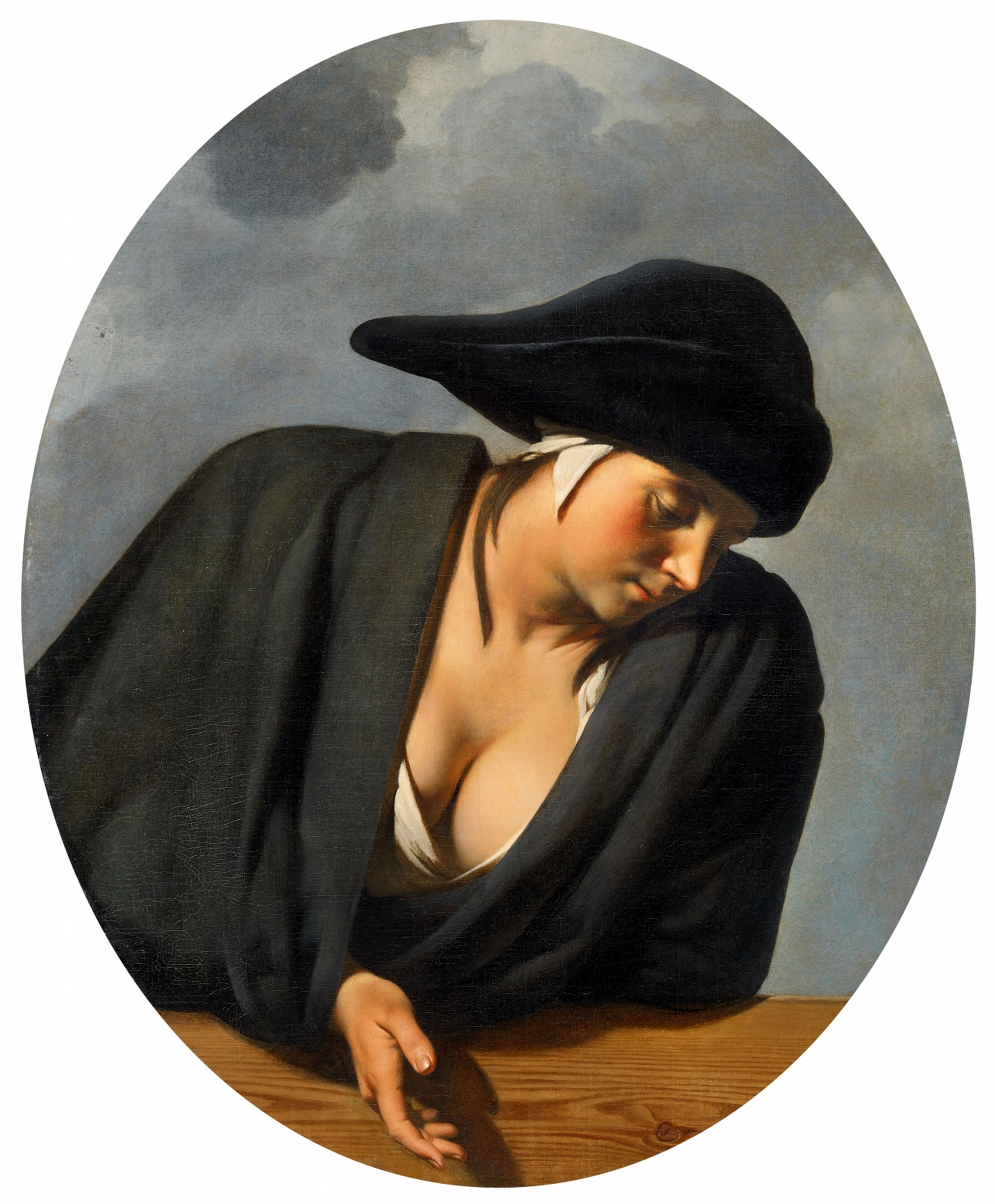Caesar Boetius van Everdingen
Young Peasant with a Lack at a Fence
Oil on canvas. 91 x 74,6 cm (oval).
Who is this young woman? What does she represent and - above all - what is she doing? After its discovery in 2002, this painting by Caesar van Everdingen remained a mystery for a long time. The woman leans against a wooden fence and bends forward, making a gesture with her hand that is difficult to interpret at first. She wears a strange hat and is wrapped in a dark cloak. As enigmatic as the iconography is, the painterly style is remarkable: due to the light, smooth flesh tones, the painting was once considered a work of French neo-classicism until Albert Blankert and Paul Huys Janssen attributed it to Caesar van Everdingen. The idea that a painting produced in 17th-century Alkmaar be attributed to late 18th-century France is testimony to Caesar van Everdingen's stylistic modernity and individuality. Moreover, the fact that the composition has puzzled for so long speaks for the inventiveness of the artist, one of the great representatives of Dutch classicism.
The headgear gives a clue to the young woman's identity. She is wearing a pointed hat as worn by Dutch peasant women depicted in contemporary images - the only difference is that she is wearing the hat the wrong way round, with the tip to the back (fig. 1; cf. Blankert, op. cit. p. 136, note 2). This produces something casual, suggestive and nonchalant in her stance. So we are dealing with the image of a young peasant and we can assume from this that she is simply leaning against the fence to feed her animals. The erotic connotation of this painting - half genre, half tronie - would not have gone unnoticed in the past, since the slightly red-cheeked young woman, by leaning forward, openly shows her décolleté and the white blouse she is wearing under her robe. Blankert assumed the painting might have been part of a ceiling decoration because of its low view-point, but this could also speak for a chimney piece. Paul Huys Janssen associated the painting with other female half-figures by Caesar van Everdingen from the years 1650 to 1655 and dated it accordingly to this period.
For a long time, the ideal of a tonal painting reigned supreme - for instance Rembrandt and his school - and shaped the ideas of 17th-century Dutch art. This led to the fact that diverging artists did not receive adequate appreciation, for example those artist that are today assigned to "Dutch Classicism". Only a series of exhibitions and publications (such as the exhibition "Dutch Classicism", Rotterdam and Frankfurt am Main 1999) have sharpened perspective on painters such as Caesar van Everdingen. This probably also explains why a masterpiece by the artist such as "A Girl with a Wide-Rimmed Hat" only entered the collection of the Rijksmuseum in 2009 (fig. 2). Caesar van Everdingen was held in high regard by his contemporaries; it was not by mere luck that he was a one of the twelve artists involved in the decoration of the Oranjezaal in Huis ten Bosch, The Hague - the most important art commission in the Netherlands in the mid-17th century (fig. 3). Caesar van Everdingen's delicate, smooth application of paint as well as his witty inventiveness, so admired by his contemporaries, are also evident in this depiction of a perky young peasant woman.
Provenance
Auction Sotheby's, London, 9.7.2002, lot 438. – Auction Sotheby's, London, 7.7.2011, lot 235. – Acquired there by the present owner.
Literature
Albert Blankert in: Christi M. Klinkert und Yvonne Bleyerveld (ed.): Painting Beauty. Caesar van Everdingen (1616/1617 - 1678). exhibition catalogue Stedelijk Museum Alkmaar, Zwolle 2016, p. 136-137, with ill.
Exhibitions
Painting Beauty, Caesar van Everdingen (1616/17 - 1678), Stedelijk Museum Alkmaar, 2016, no. 12.

